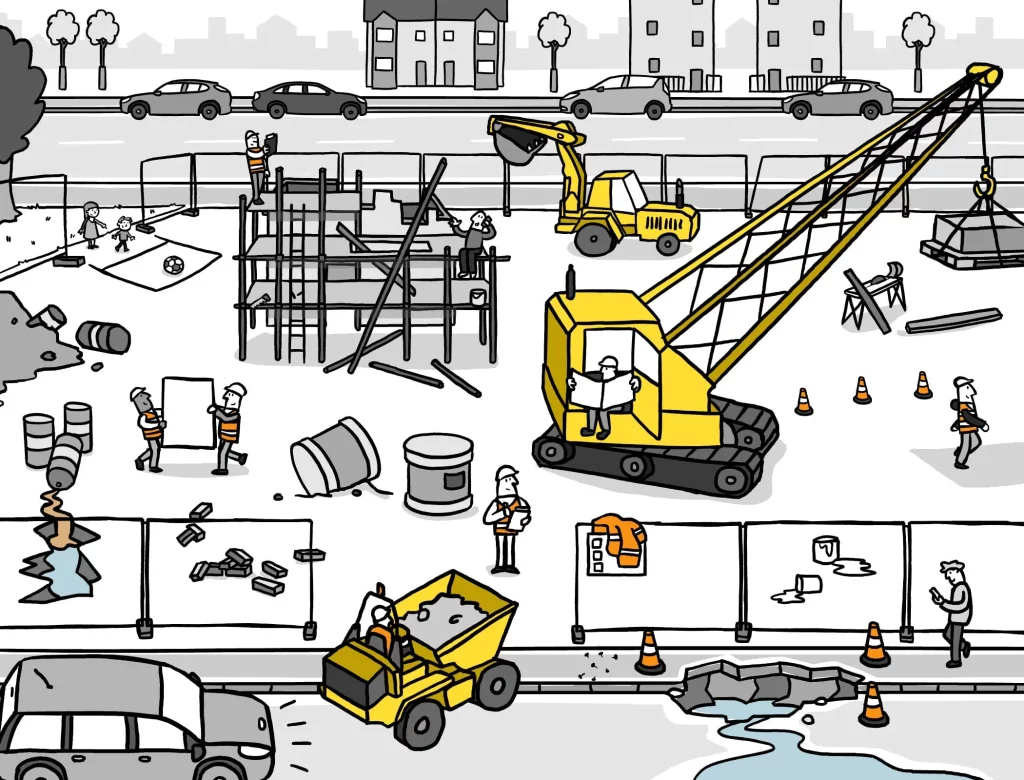
It is quite difficult to manage health and safety in the construction industry. Anyone who enters a construction site runs the danger of getting hurt, making it one of the riskiest locations to work. That’s why most contractors in the UK ask for the CSCS Labourers Card, which is a physical testament that the workers have the entry-level skills and knowledge to work on the site. To get a Labourers Card, you need to complete the CSCS Green Card (Labourers Card) Course. Hurak offers the CSCS Labourers Card Course online as well as in classroom mode.
Health and safety should be a top consideration on any construction site, whether residential or commercial. The potential health and safety risks include working at heights, using large equipment, and moving goods about the building site.
In the UK, 80,000 construction workers experience work-related ill health each year, and 64,000 sustain non-fatal injuries, according to HSE. The 2016–2017 year saw 30 fatalities related to construction. This blog lists a few of the major ailments, accidents, and fatalities that occur in construction.
Air-Borne Fibres and Toxins
According to HSE, 18,000 new cases of breathing issues1 are self-reported yearly, and there are 12,000 deaths from work-related lung diseases. Even though our sector is not entirely to blame for these issues, it is a major one. Many of these disorders take years to manifest, giving people a false sense of security and making it difficult for workers and their managers to enforce PPE properly.
The atmosphere of construction has many potential sources of lung harm. These consist of:
Stone masonry-related dust, debris removal, and general site cleanup
When installing carpet, toxic fibres can become air-borne. Isocyanates can also be inhaled as an ingredient in paints, varnishes, glues, flooring, and building insulation materials.
A variety of wood dust
Breathing in these particles can cause various illnesses, including lung cancer, silicosis, COPD (chronic obstructive pulmonary disease), occupational asthma, and silicosis.
Asbestos
Asbestos is a significant contributor to deadly respiratory diseases. When annual lung disease deaths are broken down, asbestos-related lung cancer accounts for 20% of the total. In the UK, there are almost 500,000 public buildings that contain asbestos. Older buildings have hazards for the unwary, especially electricians, including ceiling tiles, thermal paper and wall plaster, insulation, cement siding, switchgears and circuit breakers.
It is important to emphasise that asbestos poses a unique risk because a worker’s family may be at risk if they bring the dust home. When a family member is exposed to asbestos dust, a condition known as para-occupational or secondary exposure, they are also at risk of respiratory problems.
According to legal requirements for duty holders, the occupants of buildings or sites must be adequately protected from asbestos-related risks. Providing asbestos awareness training to those who might come into contact with asbestos is one way to uphold your duty of care.
Collapse
10 of the 137 workers who died at work in 2016–2017 did so due to an object collapsing. People who labour around or excavate are in danger since there are several potential outcomes. These consist of:
- entering an excavation
- the vicinity of an excavation becoming unstable and collapsing as a result of additional weights (like scaffolding or vehicles)
- compromising the stability of neighbouring buildings, resulting in their collapse
- Injury from falling objects when the excavation’s structural integrity fails
Manual Handling
Lifting, carrying, lowering, pushing, and pulling items and material loads are manual handling tasks. Although many other types of injuries are connected to material handling (bruises, punctures, fractured bones), soft tissue damage—damage to muscles, ligaments, tendons, discs, cartilage, and nerves—is the most frequent.
Soft tissue injuries typically impact the lower back, hips, legs, knees, ankles, and feet in addition to the neck, shoulders, elbows, arms, wrists, and hands. They may occur instantly or develop over time as a minor ache that gets worse with time. The degree of pain associated with the injury can range from mild to moderate discomfort to severe pain and the possibility of long-term disability. Enrol in a manual handling course to learn the correct way to handle things and prevent further damage. To further prevent manual handling injuries, follow the construction site signage to ensure clear safety signage in high-risk areas.
Noise
Slips and Trips
Working From Height
With approximately 50% of all fatal injuries in the construction profession occurring from working from heights in 2016–2017, this practice remains one of the leading causes of fatalities. Working from heights can present several risks, including:
- apertures without guards and a lack of guardrails
- insufficient edge protection
- Unsecured scaffolding or ladders
- On roofs and high pathways, loose tools and/or carelessly stored materials
Exhaustion
Suicide
Suicide is the leading cause of death, surpassing falling from heights. The UK outnumbers all other nations. The suicide rate for low-skilled male construction workers is over four times greater than the national average, according to the Office for National Statistics, making suicide 63% more likely in the construction sector than in any other reporting group. According to the statistics, 1,047 of the 10,688 “people in-work” suicides documented between 2011 and 2015 involved the construction business, making up a little over 13% of the total. Unexpectedly, mental health is the biggest concern in the construction sector rather than physical health.
Why do people commit suicide more frequently than in other industries working in the construction sector? According to some, the job’s precariousness—combined with its low pay, exploitation, and bullying—is to blame.
Moving Objects
Construction sites are frequently bustling with activity, and without proper workplace management, being struck by a moving object can become dangerous, similar to slips and trips.
Several factors can cause a worker to be struck by a moving object. These consist of:
- crowded and disorganised workspaces that prevent safe manoeuvring
- lack of beepers or warning lights on moving cars
- unlit workspaces
- concentrating while near moving items
- stumbling into moving objects like machinery, pallets, or boxes
- the absence of warning signs at crossroads with traffic



